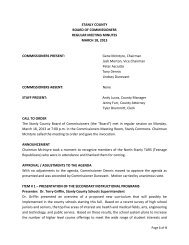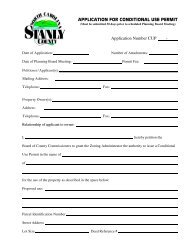Land Use Plan – 2002 - Stanly County, North Carolina
Land Use Plan – 2002 - Stanly County, North Carolina
Land Use Plan – 2002 - Stanly County, North Carolina
Create successful ePaper yourself
Turn your PDF publications into a flip-book with our unique Google optimized e-Paper software.
STANLY COUNTY<br />
APPENDIX B: BUILD-OUT SCENARIO POPULATION CALCULATIONS<br />
The following calculations were used to determine the build-out population for <strong>Stanly</strong> <strong>County</strong>.<br />
The build-out population represents the potential population that could inhabit <strong>Stanly</strong> <strong>County</strong> if all<br />
land not presently used for residential, commercial, industrial, parks, or public/semi-public uses<br />
(i.e., agricultural and wooded areas) were developed as residential areas.<br />
Steps used in the process to define this calculation include the following:<br />
1. Table B-1 identifies developable land within the study area for the <strong>Land</strong> <strong>Use</strong> <strong>Plan</strong>. This area<br />
does not include undeveloped land within municipal corporation lines or ETJs. This<br />
information is based on an existing land use inventory and analysis completed by Woolpert<br />
LLP in conjunction with Existing Conditions Analysis of the <strong>Land</strong> <strong>Use</strong> <strong>Plan</strong> (Phase 1 Report).<br />
Table B-1. Agricultural and Wooded Areas in <strong>Stanly</strong> <strong>County</strong>, 2000.<br />
<strong>Land</strong> <strong>Use</strong> Category Acres<br />
Agriculture 63,542<br />
Wooded Areas 89,048<br />
Total Agriculture and Wooded Areas 152,590<br />
Sources: <strong>Stanly</strong> <strong>County</strong> GIS Aerial Photography, April 2000.<br />
Analysis by Woolpert LLP, 2001.<br />
2. Table B-2 identifies acreage totals for land that would be developed for non-residential<br />
purposes. Generally these land uses support residential development patterns and include<br />
set-asides for transportation and utility rights-of-way and easements, as well as retail<br />
commercial, office, public (parks and schools), and semi-public (e.g., churches) uses.<br />
Table B-2. Provisions for Non-Residential Development.<br />
<strong>Land</strong> <strong>Use</strong> Category Acres<br />
Total Agriculture and Wooded Areas 152,590<br />
� Less land area for rights-of-way and public easements.<br />
Based on assumption that 15 percent of all land will be used for rights-ofways<br />
and utility easements.<br />
-22,889<br />
� Less land area for retail/commercial, industrial, community facilities<br />
and other non-residential development.<br />
Based on assumption that 5 percent of all land area will be used for these<br />
land uses.<br />
-7,630<br />
� Less set-aside for parks and recreational facilities.<br />
Based on National Parks and Recreation Association (NRPA) standard of 10<br />
acres of park for every 1,000 person, or 0.0253 acres per household,<br />
assuming 2.53 persons per household based on 2000 U.S. Census figures<br />
for <strong>Stanly</strong> <strong>County</strong>. Assumes development density in R-A, Residential-<br />
Agricultural Zoning District, of one dwelling unit/acre, or 0.0253 acres of<br />
parkland for each acre of residentially-developed land.<br />
-3,861<br />
Total Remaining Residential Development Yield<br />
Sources: <strong>Stanly</strong> <strong>County</strong> GIS Aerial Photography, April 2000.<br />
Analysis by Woolpert LLP, 2001.<br />
118,210<br />
<strong>Land</strong> <strong>Use</strong> <strong>Plan</strong> B-1 6/02






